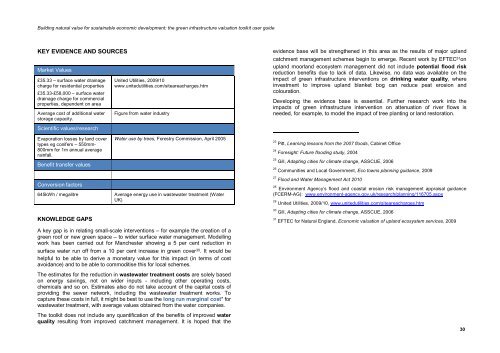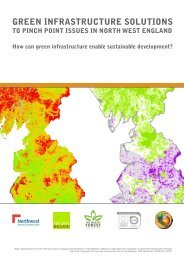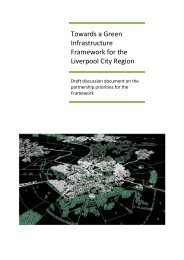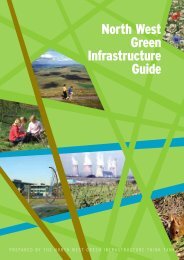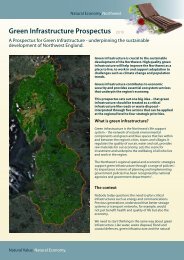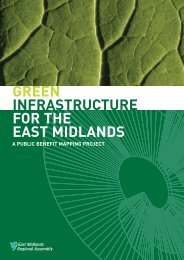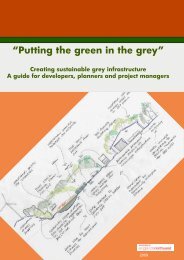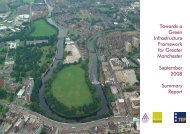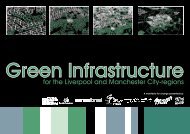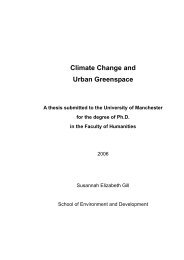The green infrastructure valuation toolkit user guide
The green infrastructure valuation toolkit user guide
The green infrastructure valuation toolkit user guide
You also want an ePaper? Increase the reach of your titles
YUMPU automatically turns print PDFs into web optimized ePapers that Google loves.
Building natural value for sustainable economic development: the <strong>green</strong> <strong>infrastructure</strong> <strong>valuation</strong> <strong>toolkit</strong> <strong>user</strong> <strong>guide</strong><br />
KEY EVIDENCE AND SOURCES<br />
Market Values<br />
£35.33 – surface water drainage<br />
charge for residential properties<br />
£35.33-£58,000 – surface water<br />
drainage charge for commercial<br />
properties, dependent on area<br />
Average cost of additional water<br />
storage capacity.<br />
United Utilities, 2009/10<br />
www.unitedutilities.com/siteareacharges.htm<br />
Figure from water industry<br />
evidence base will be strengthened in this area as the results of major upland<br />
catchment management schemes begin to emerge. Recent work by EFTEC 31 on<br />
upland moorland ecosystem management did not include potential flood risk<br />
reduction benefits due to lack of data. Likewise, no data was available on the<br />
impact of <strong>green</strong> <strong>infrastructure</strong> interventions on drinking water quality, where<br />
investment to improve upland blanket bog can reduce peat erosion and<br />
colouration.<br />
Developing the evidence base is essential. Further research work into the<br />
impacts of <strong>green</strong> <strong>infrastructure</strong> intervention on attenuation of river flows is<br />
needed, for example, to model the impact of tree planting or land restoration.<br />
Scientific values/research<br />
Evaporation losses by land cover<br />
types eg conifers – 550mm-<br />
800mm for 1m annual average<br />
rainfall.<br />
Benefit transfer values<br />
Conversion factors<br />
645kWh / megalitre<br />
KNOWLEDGE GAPS<br />
Water use by trees, Forestry Commission, April 2005<br />
Average energy use in wastewater treatment (Water<br />
UK)<br />
23 Pitt, Learning lessons from the 2007 floods, Cabinet Office<br />
24<br />
Foresight: Future flooding study, 2004<br />
25<br />
Gill, Adapting cities for climate change, ASSCUE, 2006<br />
26<br />
Communities and Local Government, Eco towns planning guidance, 2009<br />
27<br />
Flood and Water Management Act 2010<br />
28<br />
Environment Agency’s flood and coastal erosion risk management appraisal guidance<br />
(FCERM-AG): www.environment-agency.gov.uk/research/planning/116705.aspx<br />
29<br />
United Utilities, 2009/10, www.unitedutilities.com/siteareacharges.htm<br />
30<br />
Gill, Adapting cities for climate change, ASSCUE, 2006<br />
31<br />
EFTEC for Natural England, Economic <strong>valuation</strong> of upland ecosystem services, 2009<br />
A key gap is in relating small-scale interventions – for example the creation of a<br />
<strong>green</strong> roof or new <strong>green</strong> space – to wider surface water management. Modelling<br />
work has been carried out for Manchester showing a 5 per cent reduction in<br />
surface water run off from a 10 per cent increase in <strong>green</strong> cover 30 . It would be<br />
helpful to be able to derive a monetary value for this impact (in terms of cost<br />
avoidance) and to be able to commoditise this for local schemes.<br />
<strong>The</strong> estimates for the reduction in wastewater treatment costs are solely based<br />
on energy savings, not on wider inputs - including other operating costs,<br />
chemicals and so on. Estimates also do not take account of the capital costs of<br />
providing the sewer network, including the wastewater treatment works. To<br />
capture these costs in full, it might be best to use the long run marginal cost* for<br />
wastewater treatment, with average values obtained from the water companies.<br />
<strong>The</strong> <strong>toolkit</strong> does not include any quantification of the benefits of improved water<br />
quality resulting from improved catchment management. It is hoped that the<br />
30


